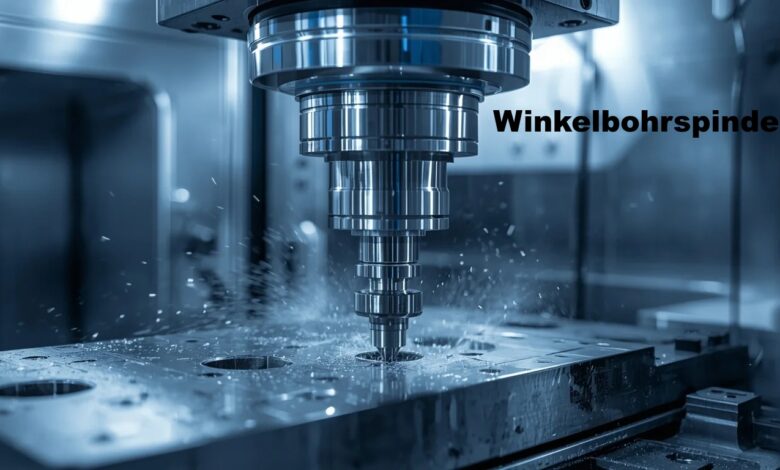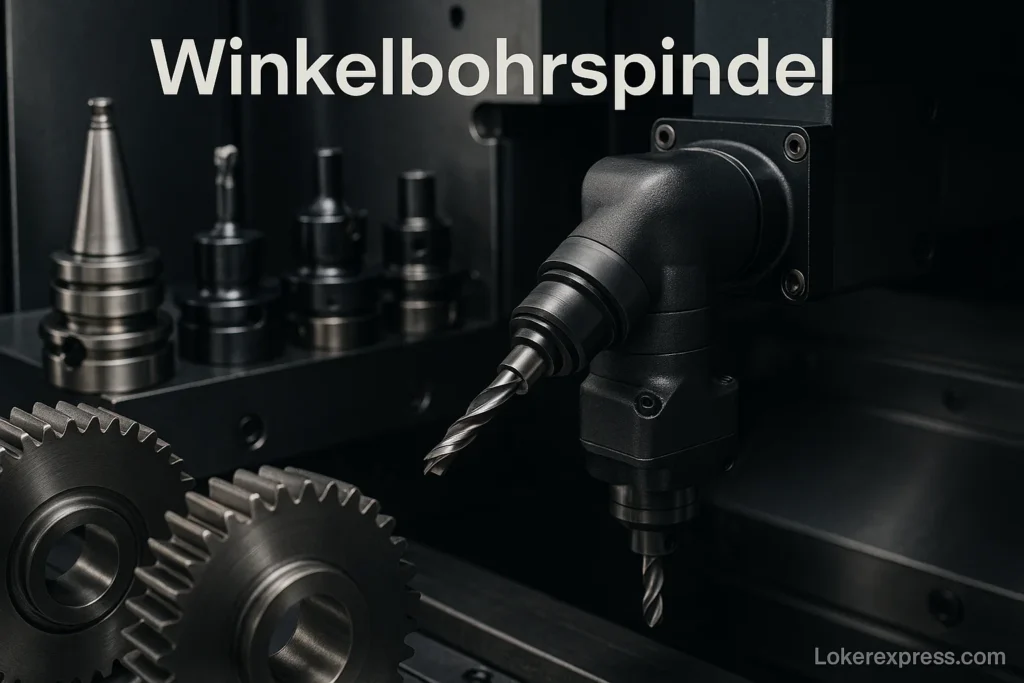Winkelbohrspindel: The Unsung Hero of Precision Engineering

Winkelbohrspindel When you think of the most important tools in modern manufacturing or machining, your mind probably jumps to CNC machines, laser cutters, or robotic arms. But buried deep inside those marvels of engineering lies a small yet powerful component that makes it all possible — the Winkelbohrspindel, or as it’s called in English, the angle drilling spindle. It might not look like much at first glance, but this tool plays a vital role in creating complex, precise, and high-quality components in countless industries.
In this article, we’ll explore what a Winkelbohrspindel is, how it works, where it’s used, and why it’s such a game-changer in modern machining and manufacturing. Whether you’re an engineer, a machinist, or just someone curious about industrial technology, you’re about to see why this humble spindle deserves way more attention than it usually gets.
What Exactly Is a Winkelbohrspindel?
At its core, a Winkelbohrspindel is a special type of spindle attachment used for drilling or machining operations at an angle. It’s typically used when a straight drilling operation isn’t possible due to space constraints, part geometry, or the need to reach otherwise inaccessible areas.
Unlike standard vertical or horizontal spindles, the Winkelbohrspindel is designed to redirect the rotational force of the machine’s main spindle at a specific angle — often 90 degrees, but it can vary depending on the model and application. Think of it as an elbow joint for your drilling setup, allowing you to get into tight spaces while maintaining accuracy and torque.
The design usually includes a robust gear mechanism, precision bearings, and a rigid housing that ensures minimal vibration and maximum stability. This allows the operator or machine to perform drilling, milling, or tapping operations with incredible precision, even when working at unconventional angles.
In other words, a Winkelbohrspindel is all about accessibility without compromise. It brings the power of a straight spindle into confined or awkward spaces, making it an essential piece of equipment for industries like automotive, aerospace, and metalworking.
How a Winkelbohrspindel Works: The Magic Behind the Angle

Now that we know what a Winkelbohrspindel is, let’s talk about how it actually works. The concept might seem simple, but the engineering behind it is quite sophisticated.
Winkelbohrspindel Inside the spindle housing lies a set of bevel gears — precisely machined gears designed to transfer rotational energy between two shafts at an angle. These gears ensure that the speed and torque of the machine’s main spindle are effectively transmitted to the tool, even though the direction has changed. The result? Smooth, powerful, and reliable rotation at a new angle.
High-end Winkelbohrspindel also feature lubrication systems, temperature-resistant bearings, and vibration dampers to ensure that the transfer of energy is both efficient and durable. In CNC applications, they can be automatically mounted and removed by the machine’s tool changer, integrating seamlessly into automated production processes.
What’s fascinating is how such a compact tool can handle enormous torque and stress without compromising accuracy. The entire system depends on precision alignment and top-tier materials — usually hardened steel or aluminum alloys — to keep everything stable under pressure.
So, even though the Winkelbohrspindel looks like a simple adapter, it’s really a mini masterpiece of mechanical engineering, designed to extend the limits of what a standard spindle can do.
Why Winkelbohrspindel Are Indispensable in Modern Manufacturing
You might wonder why anyone would go through the trouble of using such a specialized tool when regular spindles already work just fine. The answer is simple: complexity and precision.
Today’s manufacturing landscape demands parts with tight tolerances, intricate geometries, and multi-axis accessibility. Standard vertical or horizontal drilling setups often can’t reach certain areas without rotating or repositioning the workpiece — a process that adds time, cost, and potential for error. The Winkelbohrspindel eliminates these issues by bringing the drill to the angle you need.
For instance, in automotive manufacturing, it’s used to drill holes in engine blocks or transmission housings where direct access is impossible. In aerospace, it’s vital for creating angled holes in wing structures and turbine components. Even in mold and die making, Winkelbohrspindel allow machinists to finish complex internal cavities without disassembling or repositioning massive molds.
This tool not only improves accessibility but also enhances safety, since operators don’t have to perform risky manual adjustments or reach into awkward machine positions. And with automation on the rise, these spindles play a major role in reducing downtime and increasing throughput on CNC lines.
In short, Winkelbohrspindel are indispensable because they turn impossible jobs into routine operations.
Types and Configurations: Not All Winkelbohrspindel Are the Same
Just like any precision tool, Winkelbohrspindel come in many shapes, sizes, and configurations — each designed for specific applications and machine setups.
Winkelbohrspindel The most common type is the 90-degree spindle head, which redirects the rotation at a right angle. These are perfect for drilling side holes or working on the internal walls of components. However, manufacturers also produce adjustable-angle spindles, allowing users to fine-tune the drilling angle between 0° and 90°, giving even greater flexibility for complex parts.
There are also multi-spindle versions, which feature two or more drilling heads at different angles. These are particularly useful for mass production, where multiple holes need to be drilled simultaneously from different directions — cutting down cycle times dramatically.
Then there’s the question of mounting and compatibility. Some Winkelbohrspindel are designed for manual use, easily attached to hand drills or milling machines, while others are fully automated for CNC systems, complete with quick-change adapters, coolant channels, and digital angle sensors for precision alignment.
Choosing the right spindle depends on factors like torque requirements, spindle speed, tool size, and of course, the geometry of the workpiece. The right configuration can make the difference between a frustrating job and a flawless operation.
Maintenance and Longevity: Keeping Your Winkelbohrspindel in Top Shape
A Winkelbohrspindel might be tough, but like all precision tools, it needs proper care to perform its best.
Regular inspection and maintenance are crucial to prevent wear on the internal gears and bearings. This usually involves checking for any abnormal noise, vibration, or heat buildup during operation — signs that the lubrication might be insufficient or the components are misaligned.
It’s also vital to ensure that the coolant channels are clean and that the spindle is properly balanced before each use. Even a small imbalance at high speeds can lead to poor surface finishes or even tool failure.
Manufacturers typically recommend scheduled servicing every few hundred operating hours, especially for high-speed CNC applications. With proper maintenance, a quality Winkelbohrspindel can last for years, delivering precise and reliable results throughout its lifespan.
The best part is that many modern models are designed for easy servicing, with quick-access panels and modular components that make it simple to replace worn parts without disassembling the entire unit.
The Future of Winkelbohrspindel: Smarter, Smaller, and More Capable
As with everything in manufacturing, Winkelbohrspindel are also evolving. The latest trends are pushing these tools toward smart technology, with embedded sensors for vibration, temperature, and torque monitoring. These smart spindles can communicate with CNC machines to automatically adjust feed rates, speeds, or cooling, preventing damage and ensuring consistent quality.
We’re also seeing advances in miniaturization. Compact, lightweight spindles are making it possible to perform angled machining in tighter spaces — perfect for industries like electronics and micro-mechanics.
Another exciting development is the integration of additive manufacturing (3D printing) with CNC machining. In hybrid systems, Winkelbohrspindel help reach areas of printed components that need finishing or precision drilling, blending the best of both worlds.
Simply put, the Winkelbohrspindel isn’t just surviving in the age of automation — it’s adapting, evolving, and thriving.
Final Thoughts: Why the Winkelbohrspindel Deserves More Credit
It’s easy to overlook the small parts of big machines, but that’s exactly where the magic often happens. The Winkelbohrspindel might not be the flashiest component in a workshop, but it’s one of the most versatile and valuable. It allows engineers and machinists to push the boundaries of what’s physically possible, enabling precision, efficiency, and creativity in manufacturing.
Winkelbohrspindel Whether it’s crafting the next generation of jet engines or producing the intricate parts that power electric vehicles, this humble angled spindle continues to prove that sometimes, the real heroes of innovation work quietly behind the scenes.



